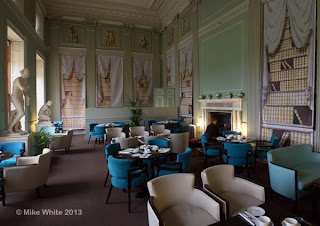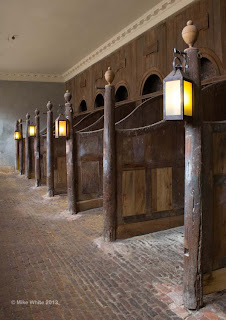Assignment Three: Buildings in Use
Minal Church
The church of St John the Baptist in Mildenhall (pronounced Mynal) near Marlborough dates from Saxon times, but by 1816 it was in disrepair and was refurbished, including the installation of its most striking feature, the box pews.According to a leaflet in the church, Sir John Betjeman referred to St. John's as "a church of a Jane Austen novel", and indeed it was a location used in an ITV film of Emma in 1996.
The pews keep draughts out and bored children in, but their main function was to define territories belonging to the families of the village. No doubt those who put up the money for the refurbishment were rewarded with the best locations.
It's a very pretty and cosy church, still used for its original function.
St Peter's, Marlborough
St Peter's church enjoys a prime location at one end of Marlborough's broad High Street (markets Wednesday and Saturday) yet the parish church is St Mary the Virgin, hidden behind houses and businesses at the other end of High Street. It was built in 1460 and various alterations have been made since.According to a sign in the church, "This former Parish Church became a Chapel of Ease of St Mary's in 1924 when the Parishes were united and St Mary's became the Parish Church. ...reports tell of candles being stolen, a fire being lit, acts of vandalism, and a tramp sleeping under the altar."
Something clearly had to be done. It was declared redundant in 1974 and leased for a peppercorn rent to a trust, which oversees community use of the building. The body of the church is now in secular use as a cafe and craft shop. The cafe seems to be camping in a very large space, but the building is also used as a parish hall for community events.
By contrast, the craft shop is packed into the rear of the church, giving a cluttered appearance.
They are both declared successful, but I can't see how either can be making much money, certainly not enough to support the fabric of the building, which involves separate fund-raising activities. At least they ensure there are people on site during daylight hours.
The Font.
There are startling juxtapositions that I'm sure bother some visitors.
The Outer Library, Attingham Park
Attingham was designed in 1782 for Noel Hill, 1st Lord Berwick and is now owned and managed by the National Trust. The outer library is in the West wing of the building. In 2013 its function changed: it is now 'Lady Berwick's Tearoom', providing teas to visitors.As part of the conversion, trompe-l'oeil blinds have been installed that conceal and protect the books. Above them are grisaille paintings by Robert Fagin, on mythological subjects, simulating bas-relief sculptures. These date from the 1790s and are of high quality.
There's a welcoming fire in the fireplace and two attractive statues oversee the room.
The space was not designed as a tea room and its conversion has presented problems. From housing thousands of dry books and a few visitors it is now a café serving hot beverages and accommodating (probably) much larger numbers of people. The books have had to be protected from steam, etc. by the blinds, which are conveniently based on the architect's original design for this room. But this protection may not be sufficient: the most valuable books have been removed and the fabric of the room will need to be closely monitored.
Lady Berwick's Tearoom, where visitors can imagine having tea with her ladyship in luxurious surroundings, served by appropriately dressed staff, was previously located upstairs in the house, which meant it was rather hidden away, and visitors had to pay the house entrance fee to use the tearoom. The present location solves the problems and disabled access is simply difficult, rather than impossible: it's a few steps up to the outer library. Being on the route most visitors take, it should attract more customers. The high ceiling and high quality decoration create the luxurious ambience that is expected of Lady Berwick's Tearoom.
The Stables, Attingham Park
Of the same date as the house and outer library, these are now chiefly used as a corridor from the entrance to the bookshop.
The stables are attractive and have been dressed with old-looking lamps.
Generations of horses and their urine have eroded the brick floors and made them uneven and the National Trust is wondering what to do about them for health and safety reasons.Names are painted on each stall; I think these were the nick-names of horses, rather than those of the stable boys. The two replaced panels may have been damaged by the horses.
The stables nearer the entrance were of higher status; the finials are more ornate.
More use is made of the high-status stables.The horse is the wrong way round, but perhaps he's also fully charged and ready for use.
The Gallery, Attingham Park
Maintenance is always needed on these old houses. The glazed lantern that provides daylight to the gallery needs attention, hence the forest of scaffolding. It's very dark and the lighting is red, presumably to protect the remaining paintings.
The lantern can be seen up the builders' ladder.
The gallery stairs are also protected.
Some of the larger paintings have been left behind.The building work is costing a lot of money.
The gallery is usually a fairly well-lit room; the predominant colour being the green of the carpet. To see it gloomy red in a forest of scaffolding alters the character entirely. The route through it is required to provide access to the rest of the house to complete the tour. But for me it was the place I most wanted to be.
Choices
I've selected two churches, but they are of very different sizes and current use. I thought it was interesting to contrast them: the little Georgian church; a nut-brown gem in a quiet village, but still fulfilling its original purpose; the large fifteenth century church, redundant and rather uncomfortable in its new use.I also selected three locations at Attingham Park, choosing rooms with different design functions, uses and states. It's a place I'm very familiar with.
Technical and Lessons Learned
It's rarely absolutely necessary to use a tripod; in any case their use is prohibited in many locations. As an aside, I must practise the use of a tripod, though. The Minal Church photographs were taken by bracing the camera against solid surfaces, as were many of the others. High ISO was used, especially in the Attingham gallery. In the stable I braced myself against walls. I used Photoshop to create two panoramas in Lady Berwick's Tearoom.I've learned a number of things about stitching panoramas from this and earlier attempts: keep the camera level; rotate the camera, rather than the photographer, because the latter creates different viewpoints and if Photoshop does manage to stitch them together, strange effects may occur. This image looks decidely odd: the wall's not straight and the statue's very distorted:


















No comments:
Post a Comment